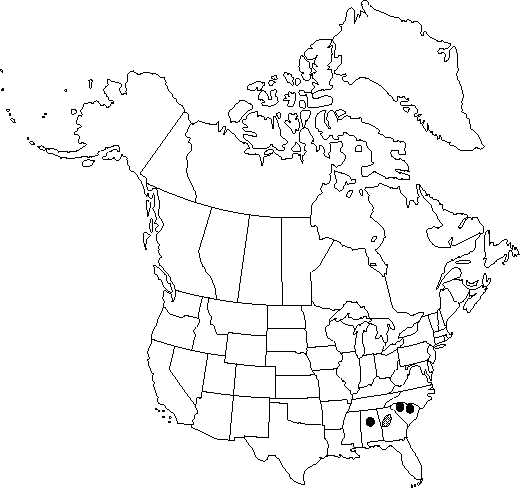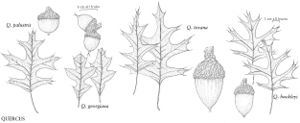Difference between revisions of "Quercus georgiana"
Amer. J. Sci. Arts, ser. 2, 7: 406. 1849.
FNA>Volume Importer |
imported>Volume Importer |
||
| (7 intermediate revisions by 2 users not shown) | |||
| Line 13: | Line 13: | ||
}}{{Treatment/ID/Special_status | }}{{Treatment/ID/Special_status | ||
|code=F | |code=F | ||
| − | |label= | + | |label=Illustrated |
}} | }} | ||
|basionyms= | |basionyms= | ||
| Line 24: | Line 24: | ||
}}<!-- | }}<!-- | ||
| − | --><span class="statement" id="st- | + | --><span class="statement" id="st-undefined" data-properties=""><b>Trees,</b> deciduous, to 15 m. <b>Bark</b> gray to light brown, scaly. <b>Twigs</b> deep red, 1-2 mm diam., glabrous. <b>Terminal</b> buds red-brown, ovoid to subconic, 2.5-5 mm, glabrous or scales somewhat ciliate. <b>Leaves</b>: petiole 6-23 mm, glabrous or with a few persistent hairs. <b>Leaf</b> blade broadly ovate to elliptic or obovate, 40-130 × 20-90 mm, base cuneate to obtuse, margins with 3-5(-7) oblong lobes and up to 10 awns, apex acute; surfaces abaxially glabrous except for conspicuous axillary tufts of tomentum, veins raised, adaxially planar, glabrous. <b>Acorns</b> biennial; cup thin, saucer-shaped, 4-6 mm high × 9-14 mm wide, covering 1/3 nut, outer surface puberulent, inner surface glabrous or with a few hairs around scar, scale tips appressed, acute; nut globose or ovoid, 9-14 × 9-14 mm, glabrous, scar diam. 4-7.5 mm.</span><!-- |
-->{{Treatment/Body | -->{{Treatment/Body | ||
| Line 31: | Line 31: | ||
|elevation=50-500 m | |elevation=50-500 m | ||
|distribution=Ala.;Ga.;S.C. | |distribution=Ala.;Ga.;S.C. | ||
| − | |discussion=<p>Quercus georgiana reportedly hybridizes with Q. marilandica (= Q. ×smallii Trelease) and Q. nigra, although D. M. Hunt (1989) has questioned the validity of the former report.</p> | + | |discussion=<p><i>Quercus georgiana</i> reportedly hybridizes with <i>Q. marilandica</i> (= Q. ×smallii Trelease) and <i>Q. nigra</i>, although D. M. Hunt (1989) has questioned the validity of the former report.</p> |
|tables= | |tables= | ||
|references= | |references= | ||
| Line 40: | Line 40: | ||
-->{{#Taxon: | -->{{#Taxon: | ||
name=Quercus georgiana | name=Quercus georgiana | ||
| − | |||
|authority=M. A. Curtis | |authority=M. A. Curtis | ||
|rank=species | |rank=species | ||
| Line 54: | Line 53: | ||
|publication title=Amer. J. Sci. Arts, ser. | |publication title=Amer. J. Sci. Arts, ser. | ||
|publication year=1849 | |publication year=1849 | ||
| − | |special status=Endemic; | + | |special status=Endemic;Illustrated |
| − | |source xml=https:// | + | |source xml=https://bitbucket.org/aafc-mbb/fna-data-curation/src/2e0870ddd59836b60bcf96646a41e87ea5a5943a/coarse_grained_fna_xml/V3/V3_431.xml |
|genus=Quercus | |genus=Quercus | ||
|section=Quercus sect. Lobatae | |section=Quercus sect. Lobatae | ||
|species=Quercus georgiana | |species=Quercus georgiana | ||
| − | |||
| − | |||
| − | |||
| − | |||
| − | |||
| − | |||
| − | |||
| − | |||
| − | |||
| − | |||
| − | |||
| − | |||
| − | |||
| − | |||
| − | |||
| − | |||
| − | |||
| − | |||
| − | |||
| − | |||
| − | |||
| − | |||
| − | |||
| − | |||
| − | |||
| − | |||
| − | |||
| − | |||
| − | |||
| − | |||
| − | |||
| − | |||
| − | |||
| − | |||
| − | |||
| − | |||
| − | |||
| − | |||
| − | |||
| − | |||
| − | |||
| − | |||
| − | |||
| − | |||
| − | |||
| − | |||
}}<!-- | }}<!-- | ||
-->[[Category:Treatment]][[Category:Quercus sect. Lobatae]] | -->[[Category:Treatment]][[Category:Quercus sect. Lobatae]] | ||
Latest revision as of 21:48, 5 November 2020
Trees, deciduous, to 15 m. Bark gray to light brown, scaly. Twigs deep red, 1-2 mm diam., glabrous. Terminal buds red-brown, ovoid to subconic, 2.5-5 mm, glabrous or scales somewhat ciliate. Leaves: petiole 6-23 mm, glabrous or with a few persistent hairs. Leaf blade broadly ovate to elliptic or obovate, 40-130 × 20-90 mm, base cuneate to obtuse, margins with 3-5(-7) oblong lobes and up to 10 awns, apex acute; surfaces abaxially glabrous except for conspicuous axillary tufts of tomentum, veins raised, adaxially planar, glabrous. Acorns biennial; cup thin, saucer-shaped, 4-6 mm high × 9-14 mm wide, covering 1/3 nut, outer surface puberulent, inner surface glabrous or with a few hairs around scar, scale tips appressed, acute; nut globose or ovoid, 9-14 × 9-14 mm, glabrous, scar diam. 4-7.5 mm.
Phenology: Flowering spring.
Habitat: Granitic outcrops and dry slopes and knolls
Elevation: 50-500 m
Distribution

Ala., Ga., S.C.
Discussion
Quercus georgiana reportedly hybridizes with Q. marilandica (= Q. ×smallii Trelease) and Q. nigra, although D. M. Hunt (1989) has questioned the validity of the former report.
Selected References
None.
